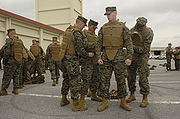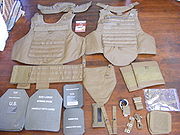
Modular Tactical Vest
Encyclopedia

Bulletproof vest
A ballistic vest, bulletproof vest or bullet-resistant vest is an item of personal armor that helps absorb the impact from firearm-fired projectiles and shrapnel from explosions, and is worn on the torso...
originally adopted by the United States Marine Corps
United States Marine Corps
The United States Marine Corps is a branch of the United States Armed Forces responsible for providing power projection from the sea, using the mobility of the United States Navy to deliver combined-arms task forces rapidly. It is one of seven uniformed services of the United States...
in 2006. The MTV was designed as a solution to shortcomings in the current, decade-old interceptor body armor
Interceptor body armor
Interceptor Body Armor is the United States Army's primary bulletproof vest. The Interceptor design replaced the older fragmentation protective Personnel Armor System for Ground Troops body armor system, introduced in the early 1980s...
(IBA) and was selected after a rigorous proposal and examination process by the Marine Corps. The MTV provides better protection levels than the IBA, although it uses the same Small Arms Protective Insert (SAPI) plates. The MTV weighs 30 pounds; three more than the IBA, but is designed to more effectively distribute its weight throughout the wearer's torso. The Navy also ordered 28,000 MTVs in August 2008.
History
After conducting a survey of more than 1,000 Marines and finding that a majority of the Marine Corps had been overall highly satisfied with the MTV, in January 2009 the Marine Corps announced that it would be making some modifications to the MTV to improve comfort, mobility and safety.However, there has been some criticism in the Marine Corps about the MTV. A small number of Marines have claimed that the previous Interceptor Body armor is dominant over the newer vest.
The Marine Corps awarded a major contract to Protective Products International (subsidiary of Protective Products of America) to produce 60,000 vests, and began fielding them in 2007 and a continued roll-out is expected.
The Navy also ordered 28,364 MTVs in August 2008.
Design

- Quick-release system to remove the vest in emergencies, meant to help corpsmen get to an injured Marine's body. Troops complained that the pull string got caught on equipment and the MTV would accidentally fall off in the middle of battle.
- Greater coverage of the lower back, side torso, and shoulders.
- Integrated side SAPI pouches.
- Integrated channels for communications wiring.
- Rifle bolster to assist in seating the wearer's rifle.
- Same modularMOLLE (military)MOLLE |female name]]) is an acronym for MOdular Lightweight Load-carrying Equipment. It is used to define the current generation of load-bearing equipment and rucksacks utilized by the United States armed forces, especially the United States Army, and its use is also growing in the British Army in...
PALS webbing as the Interceptor. - A changed closure system. This was intended to be an improvement, but some Marines have complained that it takes too long to put on because the vest slips over the head. An updated version of the MTV is currently in production to address these issues.
The vest is donned and removed using a hook-and-pile "cummerbund
Cummerbund
A cummerbund is a broad waist sash, usually pleated, which is often worn with single-breasted dinner jackets . The cummerbund was first adopted by British military officers in colonial India as an alternative to a waistcoat, and later spread to civilian use...
," which fastens around the waist, and a buckle atop each shoulder. Some users have complained that the vest is more time-consuming to don (especially with a full combat load attached) when compared to the Interceptor's single hook-and-loop flap.
The quick-release system was designed in response to concerns that the Interceptor was difficult for medical personnel to remove from incapacitated troops, and in some cases had to be cut off. When pulled firmly, a cord at the bottom of the vest causes the cummerbund to separate into two pieces. The shoulder buckles can then be unfastened and the vest removed in pieces, with no need to change the casualty's body position.
Improved Modular Tactical Vest
The IMTV is a refinement of the MTV. It has a slightly wider collar.The IMTV includes more comfort and takes the stress and weight of Marines shoulders.See also
- Interceptor Body ArmorInterceptor body armorInterceptor Body Armor is the United States Army's primary bulletproof vest. The Interceptor design replaced the older fragmentation protective Personnel Armor System for Ground Troops body armor system, introduced in the early 1980s...
- Lightweight HelmetLightweight HelmetThe Lightweight Helmet is the U.S. Marine Corps replacement for the PASGT combat helmet. As it is nearly identical to untrained eyes in shape to the PASGT, it is still called the Fritz helmet or K-pot...
- Improved Load Bearing Equipment
- Improved Outer Tactical VestImproved Outer Tactical VestThe Improved Outer Tactical Vest, or IOTV, is an enhanced version of, and a replacement for, the older Outer Tactical Vest variant of the Interceptor body armor, as fielded by the United States Army...
- PRU-70PRU-70The PRU-70/P22P-18 is an Armored Survival Vest that is intended for aircrews. It will be fielded in 3 sizes and was designed in house by Navair's Human Systems Division...
- Dragon Skin (body armor)Dragon Skin (body armor)Dragon Skin is a type of ballistic vest made by Pinnacle Armor. It is currently produced in Fresno, California. Its characteristic two-inch-wide circular discs overlap like scale armor, creating a flexible vest that allows a good range of motion and can allegedly absorb a high number of hits...
- Soldier Plate Carrier SystemSoldier Plate Carrier SystemThe Soldier Plate Carrier System or SPCS is a lightweight ballistic vest developed for the U.S. Army as an alternative to the Improved Outer Tactical Vest.-History:...

